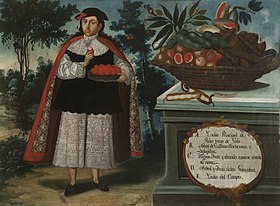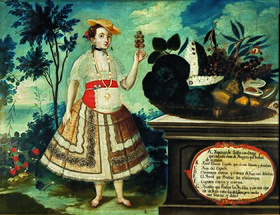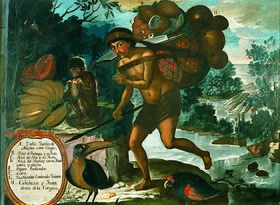Vicente Albán | |
|---|---|
 | |
| Born | 1725
Quito, Ecuador |
| Died | Unknown |
| Occupation | Painter |
Vincente Albán (1725 in Quito, Ecuador – unknown) was an Ecuadorian painter, member of the Quito School, noted for his idealized paintings of indigenous (Yumbo people) and Hispanic Criollos in their native outfits. [1] [2] These paintings depict a variety of social classes and associated clothing of the time. [3] Exploring Colonial Hispanic-American culture, he was commissioned by José Celestino Mutis, who wanted to highlight the local society, flora and fruit. [1] [4] [5] Albán painted his works by oil on canvas technique. [4]
Such paintings of this era were often used as a method of showing South American territory and its bountiful resources. Albán portrayed people shown in his paintings as wearing gold and silver jewelry to demonstrate the continent's wealth. [6]
Some of Francisco Albán's works were taken to Europe, such as the apparition of Our Lady of Aranzazu. However, from the Real Audiencia there is also evidence of two other painters, Antonio Albán, a Mercedarian friar, and Juan Albán. However, it is most likely that due to the importance of the Royal Botanical Expedition of the New Kingdom of Granada, the six paintings of Vicente Albán were the ones that, according to the illustrated style of the time, would make the greatest impression.
Paintings of local characters and fruits featured
Albán produced a series of paintings depicting a variety of social classes and information about the clothing of the time. While exploring Spanish American colonial culture, his work was commissioned by José Celestino Mutis, who wanted to bring the local flora to the mind of the country. The paintings were created through an oil on canvas technique. Paintings from this era were often used as a method of showing the American territory and the resources it provides. The people depicted in Albán's work were shown with gold and silver to demonstrate the wealth of the continent.
| Name
(main element) |
Painting [7] | Elements represented |
|---|---|---|

|
B. Tree of
sweet granadilla and its fruit
C. Loquat tree and its fruit. D. Fruit with the name of naranjilla E. Palm of large Coconuts. F. Chile cocopalm. | |

|
B. Tree of Guabas Machetonas and Berugillas.
C. Fagsos Fruit and the way its branch is entangled. D. Guava tree and fruit E. Indian of the Field. | |
Yapanga from Quito in the costume worn by this kind of women who try to please. (The "yapanga" was a colonial word linked to a woman who tries to please and is linked to a
Quechua voice meaning "barefoot" or "woman of the people"
[8])
(1783; Museo de América, Madrid) |

|
B. Capulic tree, which is very robust and leafy.
C. Prunus salicifolia fruit D. Whole and open cherimoyas are a very delicious fruit E. The tree that produces cherimoyas. F. Whole and opened Pouteria caimitos. G. A small tree that produces strawberries, which are a kind of strawberries like those of Spain, but much thicker and sweeter. |
Yumbo Indian from the vicinity of Quito with their feathered costumes and hunting animal fangs that they wear when they are in gala.
(1783; Museo de América, Madrid) |

|
B.
Cooking banana, banana tree products of the Guinean Coast with its fruit and are the most delicate.
C. Plantain, a tree that produces them called Dominicos, which are not as delicate in flavor as the first ones. D. Tree that produces the Papayas and its whole and open fruit. It is healthy E. Pineapple with its bush open and whole. It is a very fragrant and tasty fruit. |

|
B. "Indian girl" with its Paba Real (dress).
C. Avocado tree and its fruit. D. Chilguacanes tree with whole and split fruit. E. Mountain papaya tree with its fruit whole and open. F. Mammee with its leaves and open fruit. | |

|
B.
Pitaya tree and its fruit.
C. Spondias purpurea tree and its fruit. D. Mammee tree with its fruit whole and open. E. Preacher Bird. F. Parrot G. Little monkey eating banana. H. Pumpkins and fruits inside the cargo |
Other of his works
-
St. Gregory
-
Portrait of the Bishop of Quito Blas Sobrino
-
The Crucifixion
-
Virgin of the Apocalypse
-
Saint Augustine
Summary of his works
Together with his brother Francisco Albán, he painted important canvases with episodes of the Life of Saint Peter Nolasco. These were kept inside the Cloister of the Mercedarian Recollection of Tejar, in the city of Quito. Years later, in 1780, he painted a picture of the Crucifixion of Christ together with the characters that were part of the event. This painting is currently located in the Museo Jacinto Jijón y Caamaño of the Catholic University of Quito. His artistic career would change radically after the Royal Botanical Expedition to New Granada. In 1783, as a sample for the expedition leader José Celestino Mutis, he painted six paintings that were sent to Madrid. They are currently housed in the Museo de América.
For historian José María Vargas, these paintings marked a milestone in the history of Ecuadorian art, since before Vicente Albán, the painters of the Quito School concentrated on religious themes to be presented in churches and convents. Now the central theme was scientific in order to be part of a scientific expedition like so many that were made during the Enlightenment in the Spanish monarchy.
Therefore, the paintings sought to represent the figure and dresses of people from different social classes, as can be seen in the title at the bottom "Principal Lady, the Yapanga, Indian woman in gala dress. Indian man in gala dress, Yumbo Indian and Indian loader". However, in addition, representations of the products of nature are also offered. This helped Mutis to classify the different samples of Bogotá's flora, for which he relied on painters for his Labor Office.
Finally, Vicente Albán was a great portraitist. In 1783 he painted the Bishop of Quito, Blas Sobrino y Minayo.
Notable Exhibits
- 1780 - Possession of King Charles III of Spain [6] [9]
- ? - National Museum of Natural Sciences of Madrid [4]
- ? - Ethnographic Section of the National Archaeological Museum of Madrid [4]
- 1941 - Museum of America of Madrid [4]
- 2018 - National Museum of Ecuador (90 days then returned to the Museum of America of Madrid) [10]
See also
References
- ^ a b "Latin American art - Latin American art on the eve of independence". Encyclopedia Britannica. Retrieved 2019-10-01.
- ^ "Vicente Albán retrató la etnicidad del siglo XVIII". El Comercio. Retrieved 2019-10-01.
- ^ "Vicente Albán, integrante de la escuela de Quito, gran representante de la ilustración del siglo XVIII". Vicente Albán, integrante de la escuela de Quito, gran representante de la ilustración del siglo XVIII. Retrieved 2019-10-01.
- ^ a b c d e "Sociedad, flora y frutos en el Quito colonial. Vicente Albán". pueblosoriginarios.com. Retrieved 2019-10-01.
- ^ Wohletz, Sonya (2017-12-04), Abreu Xavier, António de (ed.), "Strange Fruit: Vicente Albán's Quito Series And Local Ways Of Seeing In The Era Of Colonial Enlightenment", La Península Ibérica, el Caribe y América Latina : Diálogos a través del Comercio, la Ciencia y la Técnica (Siglos XIX – XX), Biblioteca - Estudos & Colóquios, Publicações do Cidehus, ISBN 9782821897274, retrieved 2019-10-01
- ^ a b "Obras de Vicente Albán se despiden con una vista especializada en el Museo Nacional (MuNa) – Ministerio de Cultura y Patrimonio". www.culturaypatrimonio.gob.ec. Retrieved 2019-10-01.
- ^ "Vicente Albán". Digital Network of Museum Collections in Spain website. Ministry of Culture (Spain).
- ^ "Yapanga de Quito". Modernalia website. University of Castilla-La Mancha.
- ^ mundo, El Telégrafo-Noticias del Ecuador y del (2018-05-10). "Cuadros de Vicente Albán llegan a Ecuador luego de dos siglos". El Telégrafo - Noticias del Ecuador y del mundo (in European Spanish). Retrieved 2019-10-01.
- ^ "Los cuadros del artista Vicente Albán son huéspedes de la capital". El Comercio. Retrieved 2019-10-01.
Vicente Albán | |
|---|---|
 | |
| Born | 1725
Quito, Ecuador |
| Died | Unknown |
| Occupation | Painter |
Vincente Albán (1725 in Quito, Ecuador – unknown) was an Ecuadorian painter, member of the Quito School, noted for his idealized paintings of indigenous (Yumbo people) and Hispanic Criollos in their native outfits. [1] [2] These paintings depict a variety of social classes and associated clothing of the time. [3] Exploring Colonial Hispanic-American culture, he was commissioned by José Celestino Mutis, who wanted to highlight the local society, flora and fruit. [1] [4] [5] Albán painted his works by oil on canvas technique. [4]
Such paintings of this era were often used as a method of showing South American territory and its bountiful resources. Albán portrayed people shown in his paintings as wearing gold and silver jewelry to demonstrate the continent's wealth. [6]
Some of Francisco Albán's works were taken to Europe, such as the apparition of Our Lady of Aranzazu. However, from the Real Audiencia there is also evidence of two other painters, Antonio Albán, a Mercedarian friar, and Juan Albán. However, it is most likely that due to the importance of the Royal Botanical Expedition of the New Kingdom of Granada, the six paintings of Vicente Albán were the ones that, according to the illustrated style of the time, would make the greatest impression.
Paintings of local characters and fruits featured
Albán produced a series of paintings depicting a variety of social classes and information about the clothing of the time. While exploring Spanish American colonial culture, his work was commissioned by José Celestino Mutis, who wanted to bring the local flora to the mind of the country. The paintings were created through an oil on canvas technique. Paintings from this era were often used as a method of showing the American territory and the resources it provides. The people depicted in Albán's work were shown with gold and silver to demonstrate the wealth of the continent.
| Name
(main element) |
Painting [7] | Elements represented |
|---|---|---|

|
B. Tree of
sweet granadilla and its fruit
C. Loquat tree and its fruit. D. Fruit with the name of naranjilla E. Palm of large Coconuts. F. Chile cocopalm. | |

|
B. Tree of Guabas Machetonas and Berugillas.
C. Fagsos Fruit and the way its branch is entangled. D. Guava tree and fruit E. Indian of the Field. | |
Yapanga from Quito in the costume worn by this kind of women who try to please. (The "yapanga" was a colonial word linked to a woman who tries to please and is linked to a
Quechua voice meaning "barefoot" or "woman of the people"
[8])
(1783; Museo de América, Madrid) |

|
B. Capulic tree, which is very robust and leafy.
C. Prunus salicifolia fruit D. Whole and open cherimoyas are a very delicious fruit E. The tree that produces cherimoyas. F. Whole and opened Pouteria caimitos. G. A small tree that produces strawberries, which are a kind of strawberries like those of Spain, but much thicker and sweeter. |
Yumbo Indian from the vicinity of Quito with their feathered costumes and hunting animal fangs that they wear when they are in gala.
(1783; Museo de América, Madrid) |

|
B.
Cooking banana, banana tree products of the Guinean Coast with its fruit and are the most delicate.
C. Plantain, a tree that produces them called Dominicos, which are not as delicate in flavor as the first ones. D. Tree that produces the Papayas and its whole and open fruit. It is healthy E. Pineapple with its bush open and whole. It is a very fragrant and tasty fruit. |

|
B. "Indian girl" with its Paba Real (dress).
C. Avocado tree and its fruit. D. Chilguacanes tree with whole and split fruit. E. Mountain papaya tree with its fruit whole and open. F. Mammee with its leaves and open fruit. | |

|
B.
Pitaya tree and its fruit.
C. Spondias purpurea tree and its fruit. D. Mammee tree with its fruit whole and open. E. Preacher Bird. F. Parrot G. Little monkey eating banana. H. Pumpkins and fruits inside the cargo |
Other of his works
-
St. Gregory
-
Portrait of the Bishop of Quito Blas Sobrino
-
The Crucifixion
-
Virgin of the Apocalypse
-
Saint Augustine
Summary of his works
Together with his brother Francisco Albán, he painted important canvases with episodes of the Life of Saint Peter Nolasco. These were kept inside the Cloister of the Mercedarian Recollection of Tejar, in the city of Quito. Years later, in 1780, he painted a picture of the Crucifixion of Christ together with the characters that were part of the event. This painting is currently located in the Museo Jacinto Jijón y Caamaño of the Catholic University of Quito. His artistic career would change radically after the Royal Botanical Expedition to New Granada. In 1783, as a sample for the expedition leader José Celestino Mutis, he painted six paintings that were sent to Madrid. They are currently housed in the Museo de América.
For historian José María Vargas, these paintings marked a milestone in the history of Ecuadorian art, since before Vicente Albán, the painters of the Quito School concentrated on religious themes to be presented in churches and convents. Now the central theme was scientific in order to be part of a scientific expedition like so many that were made during the Enlightenment in the Spanish monarchy.
Therefore, the paintings sought to represent the figure and dresses of people from different social classes, as can be seen in the title at the bottom "Principal Lady, the Yapanga, Indian woman in gala dress. Indian man in gala dress, Yumbo Indian and Indian loader". However, in addition, representations of the products of nature are also offered. This helped Mutis to classify the different samples of Bogotá's flora, for which he relied on painters for his Labor Office.
Finally, Vicente Albán was a great portraitist. In 1783 he painted the Bishop of Quito, Blas Sobrino y Minayo.
Notable Exhibits
- 1780 - Possession of King Charles III of Spain [6] [9]
- ? - National Museum of Natural Sciences of Madrid [4]
- ? - Ethnographic Section of the National Archaeological Museum of Madrid [4]
- 1941 - Museum of America of Madrid [4]
- 2018 - National Museum of Ecuador (90 days then returned to the Museum of America of Madrid) [10]
See also
References
- ^ a b "Latin American art - Latin American art on the eve of independence". Encyclopedia Britannica. Retrieved 2019-10-01.
- ^ "Vicente Albán retrató la etnicidad del siglo XVIII". El Comercio. Retrieved 2019-10-01.
- ^ "Vicente Albán, integrante de la escuela de Quito, gran representante de la ilustración del siglo XVIII". Vicente Albán, integrante de la escuela de Quito, gran representante de la ilustración del siglo XVIII. Retrieved 2019-10-01.
- ^ a b c d e "Sociedad, flora y frutos en el Quito colonial. Vicente Albán". pueblosoriginarios.com. Retrieved 2019-10-01.
- ^ Wohletz, Sonya (2017-12-04), Abreu Xavier, António de (ed.), "Strange Fruit: Vicente Albán's Quito Series And Local Ways Of Seeing In The Era Of Colonial Enlightenment", La Península Ibérica, el Caribe y América Latina : Diálogos a través del Comercio, la Ciencia y la Técnica (Siglos XIX – XX), Biblioteca - Estudos & Colóquios, Publicações do Cidehus, ISBN 9782821897274, retrieved 2019-10-01
- ^ a b "Obras de Vicente Albán se despiden con una vista especializada en el Museo Nacional (MuNa) – Ministerio de Cultura y Patrimonio". www.culturaypatrimonio.gob.ec. Retrieved 2019-10-01.
- ^ "Vicente Albán". Digital Network of Museum Collections in Spain website. Ministry of Culture (Spain).
- ^ "Yapanga de Quito". Modernalia website. University of Castilla-La Mancha.
- ^ mundo, El Telégrafo-Noticias del Ecuador y del (2018-05-10). "Cuadros de Vicente Albán llegan a Ecuador luego de dos siglos". El Telégrafo - Noticias del Ecuador y del mundo (in European Spanish). Retrieved 2019-10-01.
- ^ "Los cuadros del artista Vicente Albán son huéspedes de la capital". El Comercio. Retrieved 2019-10-01.





